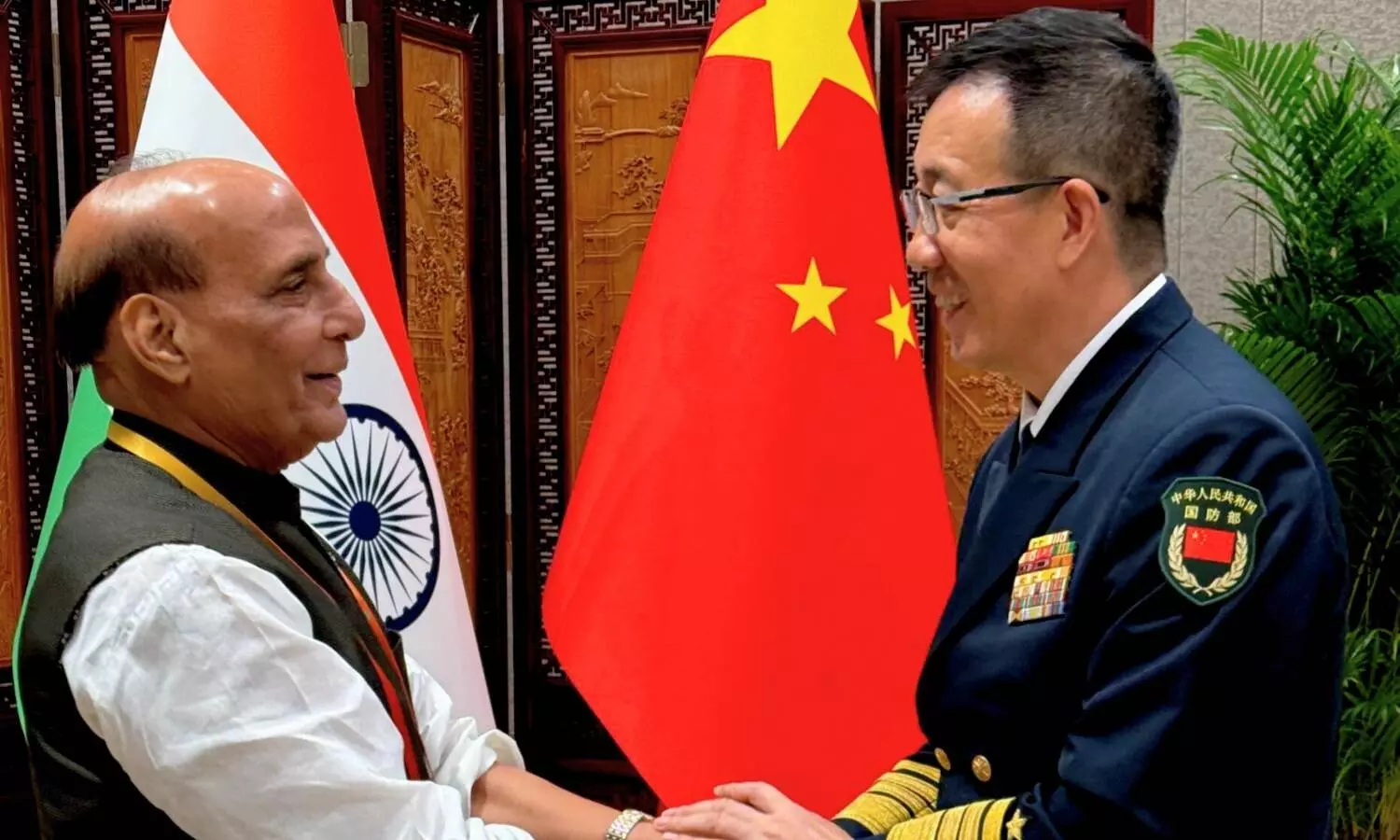Rajnath meets Chinese counterpart; calls for solving complex issues under structured roadmap

Qingdao: Defence Minister Rajnath Singh has proposed to his Chinese counterpart Dong Jun that India and China should solve the "complex issues" under a structured roadmap comprising steps to de-escalate tensions along the frontiers and rejuvenate the existing mechanism to demarcate the borders. Singh and Dong held bilateral talks on the sidelines of a conclave of the Shanghai Cooperation Organisation (SCO) in this Chinese port city on Thursday, with a focus on maintaining peace and tranquillity along the Line of Actual Control (LAC). The Indian defence minister emphasised the need to create "good neighbourly conditions" to achieve the best mutual benefits and called for "taking action on the ground" to bridge the "trust deficit" resulting from the 2020 eastern Ladakh border standoff, according to an Indian readout.
Singh also briefed Dong on the Pahalgam terror attack targeting innocent civilians, and India's Operation Sindoor to dismantle the terrorist networks in Pakistan, the defence ministry said in New Delhi. The two ministers agreed to continue consultations at various levels to achieve progress on issues related to disengagement, de-escalation, border management and eventual delimitation through existing mechanisms, it said. The Singh-Dong meeting came amid efforts by both New Delhi and Beijing to reset their ties following an understanding last October to end the military standoff along the Line of Actual Control (LAC) in eastern Ladakh. In a social media post, Singh described the talks with Dong as "constructive". "We had a constructive and forward-looking exchange of views on issues pertaining to bilateral relations. Expressed my happiness on the restarting of the Kailash Mansarovar Yatra after a gap of nearly six years," he said. "It is incumbent on both sides to maintain this positive momentum and avoid adding new complexities in the bilateral relationship," he added. The defence ministry said Singh and Dong held in-depth discussions on the need to maintain peace and tranquillity along the Indo-China border.
It said Singh acknowledged the work being undertaken by both sides to bring back a semblance of normalcy in the bilateral relations. "He highlighted the necessity of solving the complex issues through a structured roadmap of permanent engagement and de-escalation," it said in the readout. "Singh also stressed border management and having a permanent solution to border demarcation by rejuvenating the established mechanism on the issue," it said. The ministry said the defence minister "emphasised the need to create good neighbourly conditions to achieve the best mutual benefits as well as to cooperate for stability in Asia and the world". "He also called for bridging the trust deficit created after the 2020 border standoff, by taking action on the ground," it noted. The ministry said Singh highlighted the important milestone of reaching 75 years of the establishment of diplomatic relations between the two countries and appreciated the resumption of Kailash Manasarovar yatra after a gap of five years. Singh also presented Dong a Madhubani painting called 'Tree of Life' that symbolised wisdom and vitality, officials said. Madhubani art painting has its origin in the Mithila region of Bihar. This painting is a symbol of wisdom and vitality.
According to a Chinese readout, Singh said in the meeting with Dong that India does not seek conflict or confrontation with China and is willing to properly handle differences, enhance communication and promote mutual trust for the steady development of bilateral relations. Singh's visit to Qingdao coincided with the resumption of the Kailash Manasarovar Yatra in Tibet. It is taking place after a gap of nearly five years. The Kailash Mansarovar Yatra was suspended initially in 2020 because of the COVID-19 pandemic and subsequently because of the military standoff between the two sides on the Line of Actual Control (LAC) in eastern Ladakh. The pilgrimage to Mount Kailash and Mansarovar Lake in China’s Tibet Autonomous Region holds religious significance to Hindus as well as Jains and Buddhists. The military standoff in eastern Ladakh began in May 2020, and a deadly clash at the Galwan Valley in June that year resulted in a severe downturn in ties between the two neighbours. The face-off effectively ended following completion of the disengagement process from the last two friction points of Demchok and Depsang under an agreement finalised on October 21 last year. In December last, NSA Doval visited Beijing and held talks with Wang under the framework of Special Representatives (SR) dialogue on the boundary dispute. The decision to revive the SR mechanism and other such dialogue formats was taken at a meeting between Prime Minister Narendra Modi and Chinese President Xi Jinping in Kazan on October 23. The Modi-Xi meeting came two days after India and China firmed up a disengagement pact for Depsang and Demchok. Doval visited China this week as well to attend a conclave of top security officials of the SCO.



